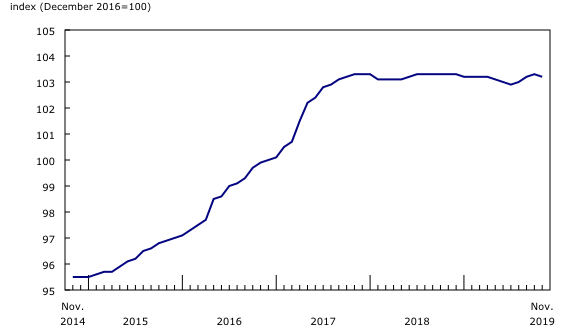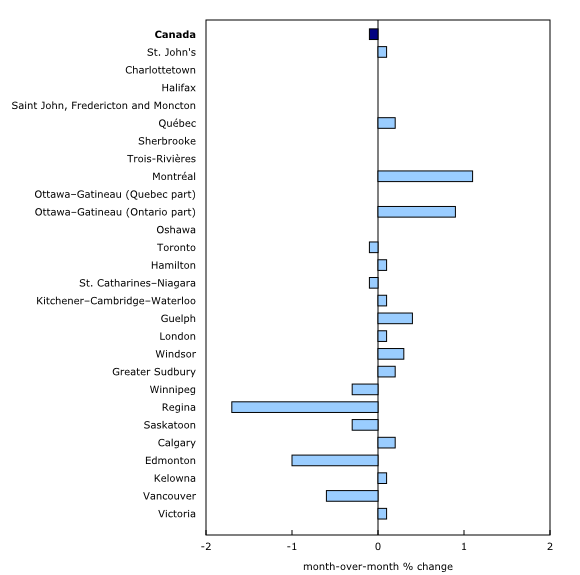New Housing Price Index, October and November 2019
Archived Content
Information identified as archived is provided for reference, research or recordkeeping purposes. It is not subject to the Government of Canada Web Standards and has not been altered or updated since it was archived. Please "contact us" to request a format other than those available.
Released: 2019-12-20
November 2019
-0.1% 
(monthly change)
November 2019
0.1% 
(monthly change)
November 2019
0.0%
(monthly change)
November 2019
0.0%
(monthly change)
November 2019
0.0%
(monthly change)
November 2019
0.8% 
(monthly change)
November 2019
0.1% 
(monthly change)
November 2019
-0.3% 
(monthly change)
November 2019
-0.8% 
(monthly change)
November 2019
-0.5% 
(monthly change)
November 2019
-0.5% 
(monthly change)
New housing prices were down 0.1% in November, following three consecutive monthly increases.
New Housing Price Index, monthly change
In November, the largest decreases were in Regina (-1.7%) and Edmonton (-1.0%). Builders in both census metropolitan areas (CMAs) offered cash rebates as incentives to buyers and also reported lower negotiated selling prices.
In October, the price of new homes declined the most in Oshawa (-0.6%) and Hamilton (-0.5%), with builders citing market conditions as the reason for the decrease.
Out of the 27 CMAs surveyed, new house prices increased the most in the CMA of Montréal (+1.1%) in November. This was the eighth consecutive monthly increase for the CMA. Builders attributed this monthly rise to new phases of developments opening.
In October, prices of new houses increased the most in Gatineau (+1.0%). The second-largest monthly increase in October and November was in Ottawa, up 0.9% in each month as a result of favourable market conditions.
New Housing Price Index, 12-month change
New house prices at the national level were down 0.1% on a year-over-year basis in November. Prices have been flat or declining since May 2019.
In October, new house prices decrease the most year over year in Vancouver (-2.5%) and Calgary (-2.1%), whereas in November, the largest 12-month declines were in Vancouver and Regina (both down 2.8%). The decline in November in Vancouver was the largest since November 2009.
For the fifth consecutive month, the largest year-over-year price increases occurred in the CMAs of Ottawa (+6.9%) and Montréal (+6.3%) in November as construction costs have remained high over the past year. This was the largest year-over-year gain in Ottawa since January 2005 and the largest in Montréal since March 2005.
Note to readers
As part of the move towards improving the timeliness of property price indices, the New Housing Price Index (NHPI) for November is released at the same time as the October index. Following this, the NHPI will be released 14 business days following the end of the reference month.
The NHPI measures changes over time in the selling prices of new residential houses agreed upon between the contractor and the buyer at the time of the signing of the contract. It is designed to measure the changes in the selling prices of new houses where detailed specifications pertaining to each house remain the same between two consecutive periods.
The survey covers the following dwelling types: singles, semi-detached and townhouses or row homes. The current value of the structure is independently indexed and is presented as the house series. The survey also collects contractors' estimates of the current value (evaluated at market price) of the land. These estimates are independently indexed to provide the published series for land. The index is available at the Canada and provincial levels, and for 27 census metropolitan areas (CMAs).
The prices collected from builders and included in the index are market selling prices less value-added taxes, such as the federal Goods and Services Tax or the provincial harmonized sales tax.
The index is not subject to revision and is not seasonally adjusted.
In addition to its monthly release, the NHPI has also been integrated into the Residential Property Price Index (RPPI). The RPPI is a quarterly series that measures changes over time in the prices of residential properties for Montréal, Ottawa, Toronto, Calgary, Vancouver and Victoria. An aggregate for these CMAs is also available. The RPPI provides for the first time a price index for all components of the housing real estate market—new and resale—in addition to a breakdown between houses and condominium apartments.
Products
Statistics Canada has an interactive NHPI dashboard. This web application provides access to new housing prices data for Canada and 27 CMAs. The maps, charts and tables draw from information collected from respondents who provide information on Canada's new housing prices. The interactive dashboard allows users to visualize statistics on the monthly and annual movements of new housing prices and on rankings by CMA of the largest monthly price movements. This web-based application is updated every month with the release of the NHPI.
The Residential Property Price Index (RPPI) Methodology is available. This document gives the details of the methodology used to calculate the NHPI, New Condominium Apartment Price Index, and Resale Residential Property Price Index, and how these indexes are compiled to form the RPPI.
The infographic "What is happening to the prices of new houses in Canada?" which is part of the series Statistics Canada — Infographics (11-627-M), looks at recent trends in new home prices for selected CMAs surveyed.
Statistics Canada has a Housing Market Indicators Dashboard. This web application provides access to key housing market indicators for Canada, by province and by CMA. These indicators are automatically updated with new information from monthly releases, giving users access to the latest data.
For more information on the topic of housing, visit the Housing Statistics Portal.
The video "Producer Price Indexes" is available on the Statistics Canada Training Institute webpage. It provides an introduction to Statistics Canada's producer price indexes—what they are, how they are made and what they are used for.
Statistics Canada has launched the Producer Price Indexes Portal as part of a suite of portals for prices and price indexes. This web page provides users with a single point of access to a wide variety of statistics and measures related to producer prices. The portal offers an array of information on topics such as manufacturing, construction, professional services, distributive trades and financial services. The portal will be continually updated as new information becomes available.
Next release
The NHPI for December 2019 will be released on January 22, 2020.
Contact information
For more information, or to enquire about the concepts, methods or data quality of this release, contact us (toll-free 1-800-263-1136; 514-283-8300; STATCAN.infostats-infostats.STATCAN@canada.ca) or Media Relations (613-951-4636; STATCAN.mediahotline-ligneinfomedias.STATCAN@canada.ca).
- Date modified:



